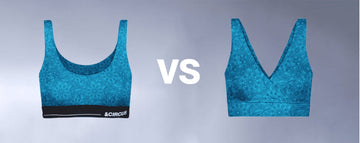Quick Listen:
The fashion industry's environmental footprint is undeniable, with synthetic textiles piling up in landfills and polluting waterways. Yet, in the intimate realm of innerwear, a transformation is underway. The global underwear market, valued at $94.5 billion in 2024 and projected to reach $147 billion by 2033 with a 5% annual growth rate, is shifting toward sustainability. Eco-conscious consumers are no longer satisfied with mere comfort or style they demand garments that tread lightly on the planet. Biodegradable materials, from organic cotton to innovative biotextiles, are redefining innerwear, blending functionality with environmental responsibility.
The Rise of Sustainable Innerwear
The textile industry has long been criticized for its role in environmental degradation, with synthetic fibers like polyester and nylon contributing to pollution and waste. Innerwear, due to its proximity to the skin and frequent replacement, faces heightened scrutiny. Enter biotextiles specialized materials crafted from natural or synthetic fibers designed to work in harmony with biological systems or to be eco-friendly for everyday use. These fabrics, including those made from mycelium, vegetable biomass, or bacterial cellulose, decompose naturally, reducing greenhouse gas emissions, water pollution, and landfill waste. They offer a sustainable alternative to the synthetic textiles that dominate the market.
Brands like AndCircus are at the forefront of this movement, prioritizing biodegradable materials that deliver comfort and durability without compromising the environment. This shift aligns with broader industry trends, particularly in the women's underwear market, a dynamic segment catering to diverse consumer needs. From everyday essentials to luxury lingerie, this market reflects evolving tastes, driven by a growing emphasis on sustainability. As eco-consciousness becomes a defining factor in purchasing decisions, biodegradable innerwear is carving out a significant niche in this $94.5 billion industry.
Innovations in Biodegradable Fabrics
The surge in biodegradable innerwear is powered by materials that combine eco-friendliness with performance. Organic cotton, valued for its softness and natural decomposition, is a cornerstone. Hemp, requiring minimal water and pesticides, is gaining popularity for its sustainability. Bamboo fibers, known for their breathability, offer another compelling option. More cutting-edge are biotextiles derived from vegetable biomass or recombinant protein-based fibers, which provide alternatives to the environmentally harmful synthetics that dominate the industry.
Consumer demand is driving these innovations. Today's shoppers seek garments that reflect their values, prioritizing sustainability alongside fit and function. This has spurred advancements in fabric technology, with features like moisture-wicking and antimicrobial properties enhancing the appeal of eco-friendly materials. As the underwear market grows steadily toward its projected $147 billion valuation by 2033, these fabrics are redefining innerwear as a blend of style, practicality, and environmental stewardship.
The push for sustainability is also reshaping production processes. Manufacturers are developing methods to process biodegradable fibers more efficiently, ensuring that eco-friendly materials meet the high standards of quality expected in innerwear. This balance of innovation and practicality is setting a new benchmark for the industry, proving that sustainability can coexist with performance.
Leaders in Sustainable Innerwear
AndCircus is a trailblazer in this space, embedding biodegradable materials into its collections to create innerwear that feels luxurious yet breaks down naturally. Their approach exemplifies a broader industry shift toward sustainability. Consider Solstiss, a 140-year-old French lace manufacturer that supplies brands like Givenchy and Valentino. When Solstiss introduced organic cotton lace, it faced the challenge of adapting its historic Leavers looms some over a century old to process delicate, eco-friendly yarns. The result is a seamless blend of tradition and sustainability, showcasing how legacy brands can embrace modern environmental goals.
Other companies are making similar strides. Patagonia, a pioneer in sustainable fashion, incorporates biodegradable materials into its activewear, including sports underwear designed for performance and eco-friendliness. Boody, an Australian brand, relies on bamboo for its softness and low environmental impact. These brands are not just producing garments; they are setting industry standards, demonstrating that innerwear can be both fashionable and responsible. Innovations in manufacturing, such as refined processing techniques for biodegradable fibers, ensure that quality and durability remain uncompromised.
Challenges in Scaling Sustainability
Despite the promise of biodegradable innerwear, challenges persist. The cost of eco-friendly materials, often sourced through labor-intensive or limited-supply processes, drives up production expenses, leading to higher retail prices. For consumers accustomed to fast fashion's low costs, this can be a barrier. Scaling production while maintaining quality is another hurdle. Natural fibers like hemp or bamboo can vary in texture and strength, complicating large-scale manufacturing.
Durability presents a unique dilemma. Biodegradable materials are designed to decompose, which is ideal for reducing waste but can conflict with consumer expectations for long-lasting innerwear. Manufacturers are tasked with finding a balance creating garments that endure daily wear yet break down naturally at the end of their lifecycle. Consumer awareness also lags. While interest in sustainable options is growing, many shoppers remain unaware of biodegradable innerwear or skeptical of its benefits, slowing widespread adoption.
Production complexities further complicate the transition. Sourcing sustainable materials at scale requires robust supply chains, which are still developing. For smaller brands, these challenges can feel daunting, but they are not insurmountable. As technology advances and consumer demand grows, the industry is finding ways to overcome these obstacles.
Opportunities for Market Leadership
These challenges are outweighed by significant opportunities. Sustainability is a powerful differentiator, particularly for younger consumers who prioritize ethical brands. Offering biodegradable innerwear can build loyalty among eco-conscious shoppers, setting brands apart in a competitive market. The environmental benefits are clear: reducing non-biodegradable waste helps address the textile industry's landfill crisis, a critical issue as global consumption grows.
For brands like AndCircus, sustainability is not just a trend it's a strategy for growth. By aligning with consumer values, they foster trust and loyalty, positioning themselves as leaders in the $147 billion underwear market projected for 2033. Supply chain improvements also offer long-term benefits. As sourcing and processing of biodegradable materials become more efficient, costs are likely to stabilize, making sustainable innerwear more accessible. Brands that invest in these practices now are poised to thrive as consumer preferences continue to evolve.
A Greener Future for Innerwear
The trajectory of the innerwear industry is unmistakably green. Experts predict that biodegradable materials will become a cornerstone of fashion as technology advances and production costs decline. Sustainability is no longer optional it's expected, notes an industry analyst, emphasizing that eco-friendly products are now a market necessity. The underwear market, with its focus on daily wear and personal comfort, is uniquely positioned to lead this transformation.
For AndCircus and its peers, the mission is clear: innovate relentlessly, educate consumers, and champion sustainability. This is not just about meeting market demand it's about shaping a future where fashion and environmental responsibility are inseparable. Consumers, too, have a role to play. Choosing biodegradable innerwear is a small but powerful act, a vote for a world where our most intimate garments leave the lightest possible mark on the planet. As we rethink our wardrobes, we have the chance to redefine fashion one sustainable stitch at a time.
Frequently Asked Questions
Why are biodegradable materials important in innerwear manufacturing?
Biodegradable materials help reduce the environmental impact of fashion by decomposing naturally, unlike synthetic fabrics that persist in landfills. Innerwear made from organic cotton, hemp, bamboo, or biotextiles offers both comfort and sustainabilitymeeting consumer demand for garments that are gentle on the planet.
What are the most common biodegradable fabrics used in sustainable innerwear?
Popular biodegradable fabrics include organic cotton for its softness, hemp for low water use and durability, bamboo for breathability, and advanced biotextiles made from vegetable biomass or bacterial cellulose. These materials provide eco-friendly alternatives without compromising performance or comfort.
What challenges do brands face when producing biodegradable innerwear at scale?
Scaling sustainable innerwear comes with hurdles like higher costs, supply chain limitations, and variability in natural fiber quality. Additionally, brands must balance durability with biodegradability and educate consumers on the benefits of choosing eco-conscious options over cheaper, synthetic alternatives.
Disclaimer: The above helpful resources content contains personal opinions and experiences. The information provided is for general knowledge and does not constitute professional advice.
You may also be interested in: Market Data Shows Shift from Fast Fashion to Durable Innerwear
Uncomfortable underwear shouldn't steal your confidence. At Andcircus, we craft ultra-soft, sustainable Lenzing Modal Micro innerwear for every body, XS to 5XL. From briefs to bras, our custom packs fit you perfectly. Shop risk-free with our 100% satisfaction guarantee and embrace comfort that includes everyone. #LoveEveryBody. Shop Now!







































